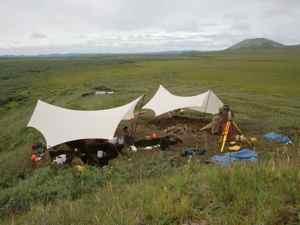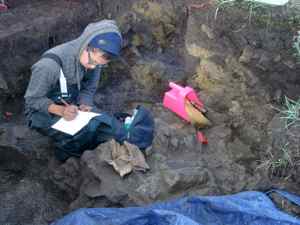Today as we troweled and sifted our way through the layers of dirt, I asked the team to talk about what things have changed in the world of archaeology and what things have really not changed very much. The consensus was that while the tools and process of excavation have not changed all that much, what is done with the artifacts that are collected has grown increasingly complex.

First off, the tools. Not much has changed with the tools. We use mason's trowels to scrape and move dirt from each of our sections. The dirt that is removed goes into buckets and then gets sifted through a screen. We use small whisk brooms to remove dirt from the larger rocks that are embedded in the bottom of each section. According to Tim, a BLM volunteer on the project, the only thing that has changed is that we use brightly colored sandbox scoops instead of dustpans to move dirt from our trowels and whisk brooms to the buckets.
The process of excavation hasn't changed much, either. Excavation is still done by dividing a site into sections and quads, using a metric scale. Each section is 1 meter square; each quad is a quarter of that. Each quad is delineated by its compass orientation; NE, NW, SE, SW. We use line levels, small levels that hang off a string, to set a line from which to measure depth. We are excavating in 5 cm increments. The line level is used to provide a constant baseline from which to measure depth. We mark each layer with some flagging attached to a metal wire that is placed at the bottom of each layer. Really, there is nothing new in this method. It's the 'standard' for archaeology.

While the methods of excavation haven't changed much over time, other aspects of archaeology have changed a lot. Everyone felt that the camps are definitely different. We are living a luxurious life compared to some of the earlier archaeological projects--even compared to this project 5 years ago. They used to bring in lots of batteries to power any electric devices. -Now we have a generator or solar panels for electricity. There used to be only one cook/storage/office tent--now we have arctic oven tents for cooking and storing food, an office tent, and a screen house for dining. All in all, archaeology camps in 2011 are pretty darn comfy.
Where the differences really appear is in what is done once the artifacts reach the lab. Lab analysis has gotten increasingly complex, with new techniques for dating, DNA analysis, and using isotopes to determine material sources. GIS (Geographic Information Systems) technology is used for site surveys and to develop correlations between sites and geographic locations and characteristics. Archaeology has also become a more integrated science, combining information and techniques from a variety of fields to create and answer questions. These techniques and relationships have resulted in the ability to ask different sorts of questions and the development of predictive models.
With increasing sophistication, archaeology is transitioning from treasure hunting to a 'real' science. Science is the process of asking questions, developing hypotheses, and using standardized data collection methods to create replicable results. In archaeology replication of results is difficult but the science is there when conclusions are derived from evidence instead of conjecture.
In spite of all these changes, one thing has remained constant, according to this archaeological team; the jokes. I guess when you spend 9 or 10 hours a day digging in the dirt with a group of people, eventually you come up with the same jokes. You can't go wrong with a few good punchlines.


Comments